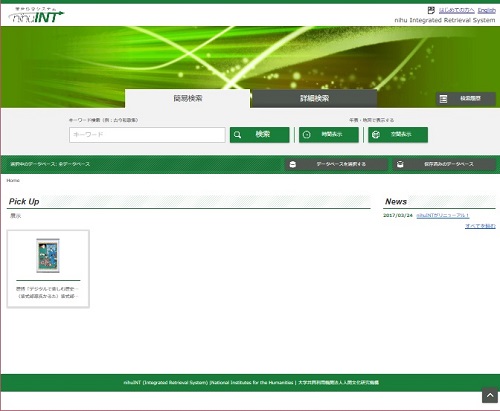Renewal of the Advanced Collaboration/Integrated Search System “nihuINT”

Center for Information and Public Relations, National Institutes for the Humanities
Project Associate Professor OUCHI Hidenori
■What is nihuINT?
The operation of nihuINT(nihu INTegrated) retrieval system, began in 2008. nihuINT is as an integrated search system that allows easy access to research resources owned by the various bodies of the National Institute of Humanities (Phase I nihuINT). It allows for a one-stop, comprehensive searching of humanities databases with a wide variety of structures and includes a spatio-temporal search function that can return search results for a specific spatio-temporal range on a timeline or a map.
Currently, it offers access to the regional research database nDP(nihu Data Provider)operated by the Institute and the six bodies of the institute; moreover, it has also collaborated with the databases of external bodies such as the National Diet Library Search(NDL Search) and the Center for Integrated Area Studies, Kyoto University(CIAS), thereby expanding the search range to 172 databases (phase II nihuINT).
■ Phase III nihuINT
Phase III nihuINT, which involved major upgrades to provide support for improved search speeds and smart devices, was announced in March 2017. Some of its features are introduced as follows.
(1) Goal-oriented search
A function to filter a target database has been introduced to more accurately provide the data that a user wants from large quantities of diverse data. However, this mechanism contradicts the cross-search feature known as an unpredictable discovery, so this issue will need to be further investigated.
(2) Smart device support
Because it was extremely difficult to view results on the small screen of a mobile terminal and the search results required considerable time to be displayed, access from a PC was envisaged in phase II of nihuINT. The aim in phase III of nihuINT was to provide a “powerful search tool that university undergraduate and graduate students studying humanities can use casually from their smartphones.” Therefore, the size of the displayed text was considered and a search function for mobile terminals that would allow agile and rapid cross-searches, instead of narrowing down functionality, was provided.
Furthermore, in phase III of nihuINT, a function to enable the transmission of search results on social networking sites, such as twitter or Facebook, was stipulated; this being an effort to enhance communication.
■Continually Evolving nihuINT
Furthermore, we shall continue to add convenient features to the current phase III of nihuINT in operation.
(1) Expanded collaboration with the databases of external institutions
Currently, we have achieved a cross-search function linking databases from various institutes, such as the National Diet Library and the CIAS, and shall further expand the collaborative databases to develop an information foundation that encompasses all humanities fields.
(2) Collaboration with repositories
Thus far, the focus of nihuINT has been on improving access to research materials; however, moving forward, we plan to collaborate with institute repositories and provide search services that enable bi-directional access to both research materials and research results.
(3) Improved cross-search functionality
To improve the standard of collaboration and cross-searches between a wide variety of databases, we are developing technology to not only align the format of metadata in advance but also create metadata to read the data contents.
(4) Support for Linked Data
Recently, we have begun database structure research using Linked Data from the perspective of flexible integrated search, as well as simple collaboration with other institutions, and reuse for the purposes of data mining. To date, we have used commonplace methods of searching databases, wherein a word is searched, and the results are selected from a list of results. Furthermore, it is expected that we shall be able to link these search results to various linked data.
(5) Support for multimedia
nihuINT began with support for inventory-type databases and supported map images with positional information in phase II. It is not yet compatible with sound sources or videos, so we shall investigate the use of multimedia in future.
When nihuINT began its service aimed at humanities resource sharing, its attempts at cross searching were not so commonplace. However, recently, information services using cross-search are being used in a wide variety of areas such as hotel reservation systems and electrical appliance price comparisons. In phase III of nihuINT, a goal for the cross-search function, as it enters its practical phase, is to make it faster, more convenient, and more refined in regard to its search services for all people interested in humanities.

phase III of nihuINT
